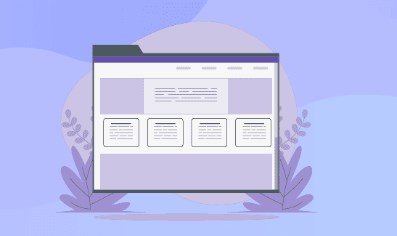In the vast expanse of the digital realm, websites stand as monuments of a brand’s presence, offering glimpses into their ethos, services, and personality. As we navigate through the timeline of the Internet, we observe an evolution – from the static, text-heavy pages of the 1990s to the dynamic, interactive platforms we know today. This evolution isn’t just about aesthetics or technology; it’s centered on the most crucial component of the web: the user.
From Humble Beginnings
The earliest websites, launched in the mid-90s, were little more than digital brochures. With limited color palettes, basic typography, and restricted multimedia capabilities, they served as information hubs, laying the groundwork for the complexities of modern websites.
The Rise of Interactivity
The 2000s saw a shift. With the advent of technologies like Flash, websites became interactive playgrounds. Animations, Learning , games, and immersive experiences became possible. However, this interactivity often came at a cost. Heavy Flash sites were notorious for long loading times, limiting accessibility for many users, especially those with slower connections.
The Mobile Revolution
The emergence of smartphones transformed the landscape once again. Websites had to adapt to varying screen sizes and orientations. The concept of “responsive design” became a staple, ensuring sites were accessible and user-friendly, regardless of the device.
User Experience at the Forefront
In today’s digital age, where countless websites vie for user attention, the importance of user experience (UX) cannot be overstated. Modern websites need to be intuitive, fast, and tailored to user needs.
Good UX goes beyond just aesthetics. It involves understanding the user journey, anticipating their needs, and ensuring that the website facilitates a seamless experience. This means quick load times, intuitive navigation, and content that resonates with the audience.
The Building Blocks of Modern Web Design
1. Minimalism and Simplicity One of the notable shifts in web design is the gravitation towards minimalism. Brands recognize that users appreciate clarity and simplicity. A clutter-free layout with clear call-to-action buttons and intuitive navigation can significantly enhance user engagement. The famous saying, “less is more,” has never been more relevant.
2. Personalization and AI Modern websites often incorporate machine learning and artificial intelligence to offer personalized experiences. Whether it’s recommending products on an e-commerce site based on browsing history or tailoring content to a user’s preferences, personalization aims to make users feel seen and understood, increasing the likelihood of them returning.
3. Micro-interactions These are subtle design elements that enhance user interaction. From a button that changes color when hovered over to a small animation indicating a form submission, micro-interactions provide immediate feedback to the user and add a touch of dynamism to the browsing experience.
4. Accessibility for All With the push for inclusivity in the digital sphere, websites now prioritize accessibility. This means ensuring that websites are usable for everyone, including those with disabilities. From color contrast to keyboard-friendly navigation, web developers are making strides to create websites that are truly for everyone.
5. Voice Search and Navigation As smart speakers and voice assistants become more prevalent, websites are adapting to voice searches. This has implications for SEO strategies and site structures, ensuring that content is easily retrievable through voice commands.
6. Sustainable and Ethical Web Design The global push for sustainability has found its way into web design. This means websites that prioritize energy efficiency, reducing their carbon footprint. Additionally, ethical considerations, such as user privacy and data protection, are at the forefront of web development discussions.
The Digital Frontier: Challenges and Opportunities in Web Evolution
1. The Challenge of Data Security As websites become more intricate, the amount of data they process has exponentially increased. Personal details, financial information, and browsing habits are just some of the data points being handled daily. This surge has necessitated robust security measures to safeguard against breaches, ensuring user trust isn’t eroded.
Opportunity: The growth in data management has led to the rise of cybersecurity as a specialized field, creating jobs and fostering innovations like blockchain and advanced encryption techniques.
2. The Shift to Progressive Web Apps (PWAs) Traditional websites and mobile apps have distinct advantages. PWAs aim to bridge the gap, offering the best of both worlds – the flexibility and accessibility of websites with the functionality and offline capabilities of apps.
Opportunity: PWAs can significantly enhance user engagement, especially in regions with inconsistent internet access, providing a seamless experience irrespective of connectivity issues.
3. The Balancing Act of Aesthetics and Performance With advances in CSS and JavaScript, websites can now have intricate animations and visual effects. However, these elements can also slow down a site, affecting user experience and SEO rankings.
Opportunity: This challenge has given rise to efficient coding practices and optimization tools, ensuring visually stunning sites don’t compromise on speed.
4. The Advent of 3D Elements and Augmented Reality Modern web capabilities allow for immersive 3D and AR experiences directly through browsers. However, these technologies can be resource-intensive.
Opportunity: As hardware technology advances, especially in mobile devices, 3D and AR experiences will become more accessible, paving the way for interactive shopping experiences, virtual tours, and more.
5. The Ethical Dilemma of Dark Patterns Some websites employ ‘dark patterns’ – design techniques that subtly manipulate users into taking specific actions, such as signing up for newsletters or making a purchase.
Opportunity: The backlash against such practices has emphasized the importance of ethical web design, prioritizing user choice and transparency.
6. Cross-platform and Cross-browser Consistency With a myriad of devices and browsers available, ensuring a consistent look and functionality for a website across all platforms can be daunting.
Opportunity: This challenge has led to the development of cross-browser testing tools and frameworks, making it easier for developers to maintain consistency.
In Conclusion The rapid evolution of web technologies presents a series of challenges, but each challenge is accompanied by opportunities for growth, innovation, and improvement. As we navigate this digital frontier, one thing remains clear: the user remains at the heart of every decision, driving the industry to new heights of creativity and excellence.





